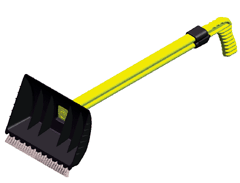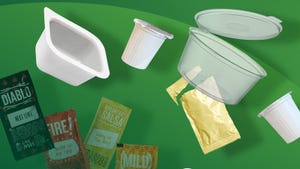Ice scraper design springs to life in race to market
February 1, 2002
Thomas Edison would be impressed. Technology has significantly increased the speed of bringing an invention to market in the 21st century. Software, virtual prototyping, virtual collaboration, and online molder sourcing have quickened the pace for new product introductions. A company called Innovation Factory used all of these tools to bring the IceDozer and the SnowMover to market this year.
A Better Scraper
About a year ago, Tucker Marion and business partner Marvin Weinberger scheduled a meeting on a winter evening. After concluding their discussions, they went out to scrape the ice and snow from their cars. They quipped about the ineffici-ency of the scrapers and wished they could find one that actually worked, one that conformed to the shape of the windshield to maximize each scraping. From that night on, Marion knew that he had to solve this issue, and having a mechanical engineering background, his need to troubleshoot was in high gear.
Soon after, Marion and Weinberger started the Innovation Factory (Havertown, PA) and funded it with venture capital. Their goal was to create interesting, highly functional consumer products. Their first endeavor began with Marion drawing up sketches of the ideal ice scraper in February 2001.
|
Three injection molded parts make up the IceDozer, a new product that went from concept to production in less than 11 months. For the handle (yellow) and body (black), designers chose polyethylene. For the blade (white), polycarbonate was chosen. |
"From the beginning, I knew that virtual team-based engineering was the right approach," says Marion, head of product development. "My intuition told me that pulling experts together in the product development cycle would get the job done." EJM Design, an accomplished industrial design firm in North Hollywood, CA, was hired to translate the concept into several possibilities. This company has worked on many well-known consumer products, such as the Teledyne Waterpik, Thermoscan, and Sensa Pen.
'The CAD part of product development is where we can quickly make things happen, and where we can compress the design cycle.' |
Design Criteria
Innovation Factory's new product would be known as the IceDozer, and the team had specific design criteria in mind. First, the blade had to conform to the shape of any automobile window. Secondly, its shape had to be ergonomic, and translate movement to maximize each scraping motion. Third, the scraper needed to be a professional grade, take abuse, and last a long time.
EJM Design came up with 17 initial concepts for the IceDozer. In the end, the team decided upon the design that most closely resembled the initial drawing, and then simplified it. By June 2001, Marion and Jim Keen, project manager of EJM Design, narrowed their focus down to the workable design. To prove the concept, they built two wooden models--a large and small version of the IceDozer. Ultimately, the optimum size was somewhere in between. EJM created 2-D scaled drawings in mid-June, and the project was then ready for hard-core engineering.
Innovation Factory went to the DVIRC (Delaware Valley Industrial Resource Center) in search of real-world manufacturing expertise. The IRC Network is an economic development organization that helps improve the competitiveness of small to medium-sized manufacturers throughout Pennsylvania. Innovation Factory also received $3000 in matching funds from the state to help move its product closer to market. DVIRC consultants Chris Yatsko and Travis Sherbine joined the IceDozer team.
Manufacturing Considerations
Following a design-for-manufacturing approach, they labored to minimize the number of parts, taking the scraper from 10 parts to three injection molded parts, further reducing its cost. Using Solid Edge, Sherbine created 3-D CAD models of the IceDozer and it was ready for virtual refinement.
"The design-for-manufacturing phase of the project presented some interesting challenges," says Sherbine. "As a machinist by trade, I was looking to make the molding as cost-effective as possible. I used mostly construction surfaces to create all three pieces of the IceDozer, and not one piece required a pull. For every pull in the injection molding process, you add 33 percent more cost to the tool. For every pull I eliminated, we saved about $5000."
After four or five CAD iterations the team linked via a conference call and gave the final thumbs up. Sherbine then exported an SLA file for rapid prototyping. Using a stereolithography model and an RTV mold created by EJM, Innovation Factory ran a series of cold weather tests. At British Aerospace's lab they tested the ice scraper using various ice thicknesses to verify the design. After rigorous testing they made one final revision to the model.
|
A second product based on the earlier invention's blade design, called the SnowMover, went from concept to production in about three months. |
Sourcing Online
Finally, it was time to source the right manufacturing contractor. With Dec. 1, 2001 as a target market release date, timing would be a major factor. Taking their need to the Internet in August, Innovation Factory posted a request for quote (RFQ) on MfgQuote.com to locate the right injection molding company. (MfgQuote.com is an interactive Web service enabling manufacturing members to buy and sell custom manufacturing services. Buyers post RFQs at no cost, and suppliers quote for business that meets their expertise and capacity.)
"We had great responses to our RFQ. Several manufacturers nationwide responded with varying quotes and a wide range of prices," stated Marion. "Based on timing and cost, we eliminated a lot of them, and settled upon VMV Tool & Engineering [Madison, IN]. Within a month, we had worked out terms and conditions. We needed a manufacturer that could offer us speed-to-market and a full solution, one that could not only produce quality parts, but also box and ship product as well. This was very important to us in our first year of production."
VMV Tool & Engineering is geared to work with entrepreneurs. Dan Vincent, co-owner of VMV, has been a CNC programmer for 17 years and explains that the company focuses on running aluminum tools at low volumes--in effect, rapid prototyping. The company builds molds and performs molding quickly and efficiently for clients who are in the market for 50 to 50,000 parts. Partner Steve Vawter, a mold designer by trade, and Vincent started VMV Tool about five years ago and have grown the company to 22 employees.
Not only did VMV have the right shop capacity, but it also had an extra 10,000 sq ft of space, normally used for secondary operations such as assembly, packaging, and shipping. The space was converted to accommodate shipping needs for the IceDozer.
Once the 3-D CAD files arrived, VMV found a few design hurdles en route to production. "Once we had the design in hand, we reviewed several sections of the product for problems and/or improvements. In the areas where the parts clip together we made modifications so the components would snap together more easily. We also spotted locations where there would be potential sink problems and performed design changes to eliminate these conditions," stated Vincent.
All tools for the Innovation Factory products were built with three-axis, high-speed Haas machining centers. The company used a 200-ton Toshiba press to produce the IceDozer. Durable materials were chosen for the IceDozer--polyethylene for the body and polycarbonate for the blade. About 100,000 units were molded for the product's introduction, which finally took place in January.
A Second Concept
With the IceDozer tooling in progress, Marion and Weinberger began developing a similar product--the SnowMover. It would safely remove large amounts of snow from a car or truck.
From a rough idea, EJM Design presented five concepts to the engineering team within a short three weeks. The chosen design went through a couple of iterations before finally becoming a clever snow plow with an innovative I-beam shaft and protective bristles on the shovel's bottom to protect a vehicle's paint job.
Once they settled upon the SnowMover's look and feel, Marion wanted to get to the CAD stage immediately. "The CAD part of the product development stage is where we can quickly make things happen, and where we can compress the design cycle," he says. "We already had the engineering team intact, and we could move forward quickly and effectively."
Sherbine again went to work on the CAD design and ran through four to five iterations to achieve a manufacturable product. "Reducing this design down to five pieces was a lot trickier than the first product. In the end, the CAD design was four injection molded pieces and one extruded piece. We had to look hard at the extrusion tolerance and intersection of the welding to come up with the right answer," says Sherbine.
Within one month the team went from paper to CAD to an SLA model, delivered in late October. The SnowMover would be made from polyethylene, and the scoop part of the shovel would be molded with polypropylene. VMV Tool began production shortly after and was ready to meet the target market date of Dec. 15, 2001.
But Marion and Weinberger are not resting on their laurels. They are already in the planning stages of producing a family of IceDozer products using their ingenious blade design. The line will include a small glove-box version, as well as a larger-sized ice scraper for big vehicles such as vans, SUVs, and trucks.
Contact information |
You May Also Like




